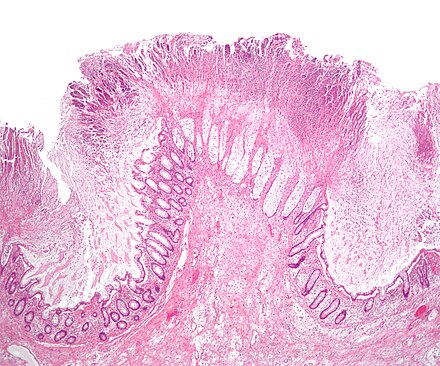Clostridioides difficile infection
Clostridioides difficile infection (CDI), also known as C. difficile colitis, is a symptomatic infection caused by the spore-forming bacterium Clostridioides difficile. It primarily manifests as watery diarrhoea, fever, nausea, and abdominal pain.
CDI accounts for approximately 20% of antibiotic-associated diarrhoea cases. The pathogenesis involves a disruption of the gut microbiota, primarily due to antibiotic use, leading to a decreased absorption of short-chain fatty acids and resulting in osmotic diarrhoea.
Serious complications may include pseudomembranous colitis, toxic megacolon, colon perforation, and sepsis.

Cause and Risk Factors
C. difficile is an anaerobic, gramme-positive, spore-forming bacterium that is commonly found in soil. It can colonise the human colon without symptoms, particularly in 2-5% of the adult population. The bacteria produce toxins, primarily enterotoxin (toxin A) and cytotoxin (toxin B), which cause diarrhoea and inflammation. Infection is often associated with recent antibiotic use, particularly fluoroquinolones, cephalosporins, and clindamycin. Other risk factors include proton pump inhibitor use, hospitalisation, other health problems, older age, and recent diarrheal illnesses.

Signs and Symptoms
In adults, CDI symptoms range from mild diarrhoea to severe, life-threatening inflammation of the colon. Clinical predictors include significant diarrhoea (more than three watery stools per 24 hours), recent antibiotic exposure, abdominal pain, fever, and a distinctive foul odour to the stool. In children, CDI often presents as watery diarrhoea with fever, loss of appetite, nausea, and abdominal pain. Severe cases can lead to significant inflammation of the colon.
Diagnosis
Diagnosis is primarily through stool testing for C. difficile toxins or its DNA. Toxigenic culture remains the gold standard but is labour-intensive. Stool culture, enzyme-linked immunosorbent assay (ELISA) for toxins, and polymerase chain reaction (PCR) testing are commonly used. Colonoscopy or sigmoidoscopy may reveal pseudomembranes on the colon mucosa, indicative of severe cases.



Prevention
Preventing CDI involves proper antibiotic prescribing, rigorous infection control protocols in healthcare settings, and handwashing with soap and water. Alcohol-based hand sanitizers are ineffective against C. difficile spores. Surfaces contaminated with spores must be cleaned with bleach solutions. Probiotics may help prevent CDI, especially in those taking antibiotics.
Treatment
Mild cases of CDI often resolve with the discontinuation of antibiotics. For symptomatic cases, first-line treatments include oral vancomycin and fidaxomicin. Metronidazole is an alternative for those who cannot tolerate the first-line treatments. For recurrent CDI, faecal microbiota transplantation (FMT) has shown high efficacy in restoring normal gut flora and preventing further recurrences.
Images of C. difficile


Epidemiology
CDI occurs worldwide, with an estimated incidence of eight cases per 100,000 people annually. In the United States, the infection rate was approximately 453,000 cases in 2011, resulting in 29,000 deaths. The emergence of a highly virulent, fluoroquinolone-resistant strain has significantly increased CDI-associated mortality rates.
History
The bacterium, initially named Bacillus difficilis in 1935, was later reclassified as Clostridium difficile and subsequently as Clostridioides difficile. The association of CDI with pseudomembranous colitis was first described in 1978.
Notable outbreaks of CDI have occurred globally, including significant incidents in Canada, the UK, and Europe, often linked to the hypervirulent NAP1/027 strain. These outbreaks have underscored the importance of stringent infection control measures and appropriate antibiotic use in preventing CDI.
Self-assessment MCQs (single best answer)
What type of bacterium is Clostridioides difficile?
Which of the following is NOT a common symptom of CDI?
What is the primary cause of the disruption of gut microbiota leading to CDI?
Which of the following antibiotics is NOT commonly associated with CDI?
What is the gold standard for diagnosing CDI?
Which treatment is recommended for mild cases of CDI?
What is a serious complication that can arise from CDI?
What preventive measure is ineffective against C. difficile spores?
Which strain of C. difficile has been linked to increased mortality rates due to its high virulence and fluoroquinolone resistance?
In which year was the association of CDI with pseudomembranous colitis first described?
Dentaljuce
Dentaljuce provides Enhanced Continuing Professional Development (CPD) with GDC-approved Certificates for dental professionals worldwide.
Founded in 2009 by the award-winning Masters team from the School of Dentistry at the University of Birmingham, Dentaljuce has established itself as the leading platform for online CPD.
With over 100 high-quality online courses available for a single annual membership fee, Dentaljuce offers comprehensive e-learning designed for busy dental professionals.
The courses cover a complete range of topics, from clinical skills to patient communication, and are suitable for dentists, nurses, hygienists, therapists, students, and practice managers.
Dentaljuce features Dr. Aiden, a dentally trained AI-powered personal tutor available 24/7 to assist with queries and provide guidance through complex topics, enhancing the learning experience.
Check out our range of courses, or sign up now!


